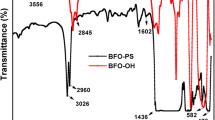Abstract
In this work, ultralow dielectric constant (ultralow-k) polysulfone (PSF) composites were prepared by adding hollow glass beads (HGB) modified with 1,3-divinyltetramethyldisiloxane (DVTM). The results indicated that the surface modification of HGB (m-HGB) effectively enhanced the interfacial compatibility between the inorganic fillers and PSF matrix. DSC and TGA measurements of the composite films were performed under a nitrogen atmosphere, and the results showed that the composite films possess high glass transition temperatures varying from 187 °C to 190 °C, and are thermally stable␣up to 445 °C. The mechanical properties of composite films with modified HGB fillers show a certain drop, but the values were still higher than 32 MPa. Furthermore, the obtained composite films show low dielectric constant, low dielectric loss, good permittivity-frequency stability and dielectric-temperature stability under 190 °C. Therefore, we shown an effective path to prepare composites with ultralow dielectric constant for use in high temperature resistant ultra large scale integration (ULSI) flexible insulation substrate field.
Similar content being viewed by others
References
Y. Luo, K. Jin, C. He, J. Wang, J. Sun, F. He, J. Zhou, Y. Wang, and Q. Fang, Macromolecules 49, 7314 (2016).
J. Li, Z. Zhang, T. Zhu, Z. Li, J. Wang, and Y. Cheng, Eur. Polym. J. 126, 109562 (2020).
J. Wang, J. Zhou, K. Jin, L. Wang, J. Sun, and Q. Fang, Macromolecules 50, 9394 (2017).
J. Chen, Y. Wang, Q. Yuan, X. Xu, Y. Niu, Q. Wang, and H. Wang, Nano Energy 54, 288 (2018).
J. Dong, C. Yang, Y. Cheng, T. Wu, X. Zhao, and Q. Zhang, J. Mater. Chem. C 5, 2818 (2017).
Z. Geng, M. Huo, J. Mu, S. Zhang, Y. Lu, J. Luan, P. Huo, Y. Du, and G. Wang, J. Mater. Chem. C 2, 1094 (2014).
Y. Wang, Y. Tao, J. Zhou, J. Sun, and Q. Fang, ACS Sustain. Chem. Eng. 6, 9277 (2018).
Y. Zhang, C. Zhao, J. Liu, and H. Na, Eur. Polym. J. 109, 110 (2018).
L. Li, C. Liu, J. Zhu, and X. Chen, J. Eur. Ceram. Soc. 35, 1799 (2015).
J. Wang, K. Jin, F. He, J. Sun, and Q. Fang, RSC Adv. 4, 40782 (2014).
S. Saha, E. Mistri, D. Bera, and S. Banerjee, Mater. Chem. Phys. 152, 167 (2015).
X. Li, P. Zhang, J. Dong, F. Gan, X. Zhao, and Q. Zhang, Compos. Part B: Eng. 177, 107401 (2019).
Z. Pu, X. Zheng, and J. Zhong, Polym. Int. (2020). https://doi.org/10.1002/pi.5995.
Y. Liu, C. Qian, L. Qu, Y. Wu, Y. Zhang, X. Wu, B. Zou, W. Chen, Z. Chen, Z. Chi, S. Liu, X. Chen, and J. Xu, Chem. Mater. 27, 6543 (2015).
S. Park, F. Jin, and C. Lee, Mater. Sci. Eng. A Struct. 402, 335 (2005).
Y. Zou, Y. Zhan, R. Zhao, and X. Liu, J. Mater. Sci.: Mater. Electron. 24, 1238 (2012).
X. Zheng, Z. Pu, L. Hu, Y. Tian, J. Xia, J. Cheng, and J. Zhong, J. Mater. Sci.: Mater. Electron. 30, 18168 (2019).
W. Fu, S. Liu, W. Fan, H. Yang, X. Pang, J. Xu, and G. Zou, J. Magn. Magn. Mater. 36, 54 (2007).
R. Wei, L. Tu, Y. You, C. Zhan, Y. Wang, and X. Liu, Polymer 161, 162 (2019).
Z. Pu, L. Hu, Y. Tian, X. Zheng, J. Zhong, and X. Liu, J. Polym. Res. 25, 100 (2018).
Z. Pu, X. Zheng, Y. Tian, L. Hu, and J. Zhong, Polymers 9, 596 (2017).
H.T. Vo and F.G. Shi, Microelectron. J. 33, 409 (2002).
Acknowledgments
The authors wish to thank for the Opening Project of Key Laboratories of Fine Chemicals and Surfactants in Sichuan Provincial Universities (2018JXY04), Opening Project of Material Corrosion and Protection Key Laboratory of Sichuan province (2019CL04) and Major Project of Education Department in Sichuan (18ZA0346), Key science and technology planning project of Zigong (2019YYJC04).
Author information
Authors and Affiliations
Corresponding author
Ethics declarations
Conflict of interest
The authors declare that they have no conflict of interest.
Additional information
Publisher's Note
Springer Nature remains neutral with regard to jurisdictional claims in published maps and institutional affiliations.
Rights and permissions
About this article
Cite this article
Zhong, J., Zheng, X., He, G. et al. Ultralow Dielectric Constant and High Temperature Resistance Composites Based on Self-Crosslinking Polysulfone and Hollow Glass Beads. J. Electron. Mater. 49, 7581–7588 (2020). https://doi.org/10.1007/s11664-020-08491-2
Received:
Accepted:
Published:
Issue Date:
DOI: https://doi.org/10.1007/s11664-020-08491-2




